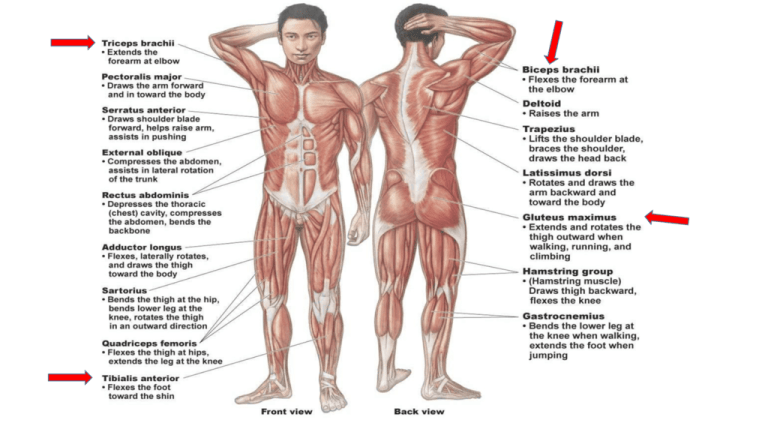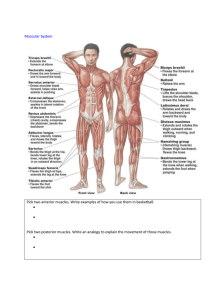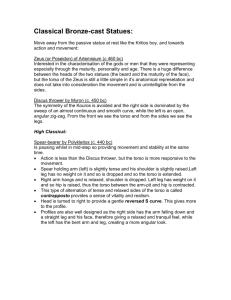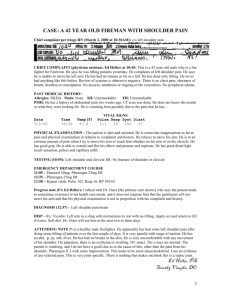File - Fourth Grade Printing Needs
advertisement

A good strategy when watching an educational video is to: 1) Watch the video, without taking notes 2) Then take notes, pause if necessary 3) Review the video again to make sure you have all the necessary information Let’s practice together… http://youtu.be/q5MyCwatq6E Watch up to minute 1:27 (Functions) Watch up from 1:27 to 4:14 (Interactions) During Physical Education Class: Begin to observe how you are using your muscles to play basketball. Here is an example of what you will “conscientiously” do during physical education class. Ask your teacher!!! Next Class Think about the muscles you use while playing basketball. Professionals Working with the Human Body Use special vocabulary to describe location and movement Glue the following information in your science notebook Location Terms Description of Location Anterior Towards the front of the body (abdomen/chest are anterior to the back) Posterior Towards the back of the body (back is posterior to the abdomen/chest) Ventral Towards the front of the torso (on the front of the body) Dorsal Towards the back of the torso (on the back of the body) Medial Towards the center or midline of the body (the sternum is medial to the shoulder). Lateral Away from the midline of the body – to the side (the shoulder is lateral to the sternum). Below – in relation to another structure (feet are inferior to knees) Inferior (Caudal) Superior (Cranial) Above – in relation to another structure (knees are superior to feet) Proximal Nearest the trunk or point of origin of the limb (shoulders are proximal to elbows) Distal Situated away from the center or midline of the body or away from the point of origin, closer to the end of the limbs (the hand is distal). Contralateral Pertaining or relating to the opposite side. Ipsilateral On the same side Transverse Horizontally across the body Guess! Use the chart in your notebook. 1) ________ is a muscle that originates on the surface of the 1st to 8th ribs at the side of the chest and inserts along the entire anterior length of the medial border of the scapula. 2) _________ is a muscle located lateral to the pectoralis major, anterior border of the clavicle and posterior from the scapula. 3) ______is an anterior muscle, medial to the thigh, inferior to the torso, and contains four muscles. 4) ______is a posterior, ipsilateral and inferior to the torso muscle. Answers: 1) 2) 3) 4) Serratus Anterior Deltoid Quadraceps Femoris Gluteus Maximus You try! Write the location of two different muscles using the correct anatomical vocabulary. Write both on index cards for your game. Do all the movements in the next chart Learn the vocabulary to use on Physical Education Class. Movements Flexion Description Decreasing the inner angle of the joint Examples Bending the elbow Dropping the chin to the chest Folding forward (flexion of spine) Back bend Kicking leg back (hip extension) Lifting leg to the side Lifting arms up from sides into T position Crossing one leg in front of the other Crossing arm in front of torso or behind back Dropping ear towards shoulder, Crescent Stretch (dropping one hand down same side of body) Extension Increasing the inner angle of the joint Abduction Moving away from the midline of the body Adduction Moving towards the midline of the body Lateral Flexion Sidebending (neck/torso) Rotation Rotating or pivoting around a long axis Circumduction Dorsiflexion Circular movement Flexing the ankle with foot moving upwards Twisting along spinal column (seated twist) Turning palms up and down Arm circles Lifting toes up towards body Plantarflexion Flexing the ankle with foot moving downward Pointing toes Pronation Rotating the forearm with the palm turning inward Lifting arm then turning arm (like emptying a can of soda) Supination Rotating the forearm with the palm turning outward Lifting arm then turning arm back (turning palms towards ceiling) Inversion Turning sole of foot medially (inward) Turning feet in, turning toes towards each other Eversion Turing sole of foot laterally outward Turning feet out, bringing backs of heels towards each other. Horizontal Abduction Move arm in horizontal plane away from the body Bring arms to shoulder height and pull arms back (opening through chest) Horizontal Adduction Moving arm in horizontal plane inwards across body Crossing arms in front of the chest Protraction Retraction Draw forward (shoulder) Draw back (shoulders) Round shoulders forward “spreading” back Squeezing shoulder blades together





